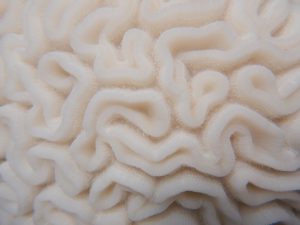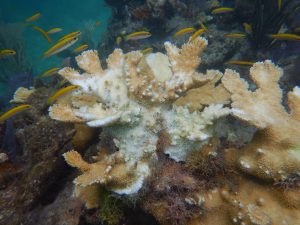Imagine you are accustomed to eating 2,000 calories per day. What if your diet was suddenly cut by 85% to only 300 calories per day? You could survive on 300 calories per day, but for how long? This is the issue facing the bleached corals living on Florida’s Coral Reef during the current marine heat wave, Summer 2023.
What is coral bleaching?
Corals are animals that live in a symbiotic relationship with microscopic algae called zooxanthellae. Zooxanthellae are unicellular golden-brown algae that live inside coral tissues and belong to the algal group called dinoflagellates. This is a mutualistic symbiosis because both species benefit from their interactions. If you think of a single coral, it is a colony of hundreds to thousands of tiny genetically identical coral polyps. Each coral polyp is like a condominium for the zooxanthellae to live in — the coral provides high-rise housing with plenty of sunlight and a protective security system of stinging tentacles. The zooxanthellae use the carbon dioxide and water released from the coral’s respiration for photosynthesis to produce the food they need. In return, the zooxanthellae provide the corals with the sugars and amino acids they use as the building blocks for food, which supplies the majority of the coral’s nutrition (>85%).

Corals have precise temperature requirements. Just like humans, they become uncomfortable and stressed when they are outside of their thermal tolerance zone. The corals in the Florida Keys are most comfortable when water temperatures are between 73-84⁰ Fahrenheit. Once the temperature exceeds 88⁰F, corals may start to expel the zooxanthellae from their living tissues. In addition to providing most of the coral’s nutrition, the zooxanthellae are what provides the coral’s color. This is why coral bleaching turns the individual coral polyps transparent and you can see the white mineral skeleton underneath – because these microalgae have been expelled from the living coral polyp.
Corals use their tentacles full of stinging cells to capture zooplankton but this is a small percentage of their diet (<15%). This is why short-term coral paling and bleaching does not usually lead to coral mortality; the coral polyp is still able to find food, just not enough to survive more than a couple of weeks of above-average water temperatures. When the food deficit lasts longer than the corals can tolerate, these corals will die from starvation.
What is the extent of the bleaching you have seen?

As of July 24, 2023, coral bleaching has been documented from Key Largo to Key West, Florida. Underwater temperature gauges at many sites within the Florida Keys National Marine Sanctuary are recording temperatures over 93⁰F. According to NOAA, the current sea temperatures in many locations in South Florida are 95⁰F degrees – these are the warmest water temperatures ever recorded in July since water temperature readings began at the reefs in 1981. (Note: average annual summer sea temperatures are 74-88⁰F).
Is this a direct result of the increased ocean temperatures?
Yes, the cause of this summer’s coral bleaching is directly related to higher-than-average water temperatures over 88⁰F. Mild bleaching has occurred within the Florida Keys National Marine Sanctuary for the past 5 years, which typically occurs at the end of August. The current marine heat wave is concerning because it started early in the season and NOAA forecasts a 70-80% probability that above-average ocean temperatures could persist until October 2023.
How long will it take for the coral to make a comeback?
Corals can survive bleaching events. They are able to recolonize the zooxanthellae and although stressed, usually recover. When corals die en masse, it is very difficult for the coral reef to survive as a living functional coral reef. It takes hundreds of years for a very large boulder coral or brain coral to grow to a large size since their growth is slow and measured in centimeters per year. In the meantime, nuisance species like Palythoa and algae can quickly colonize the real estate left behind, and then it is more difficult for corals to recover and compete for that physical space on the reef.
What effects can coral bleaching have for South Florida?
Florida’s Coral Reef is already eroding faster than it is accreting. If we lose that living coral veneer, we will lose the protection coral reefs provide to the land. These large boulder and brain corals, and the smaller branching corals -staghorn and elkhorn corals- are the corals that protect the land from storms and hurricanes. Functioning coral reefs attenuate wave energy and protect the coast and beaches from erosion and storm surges. The value of a functioning coral reef for property protection is worth billions of dollars in South Florida. When you hear the boating report that says “waves outside the reef are 4-5 feet and waves inside the reef are 1-2 feet” – it is the living coral reef that is providing that decrease in wave energy. This protects your home and your property, and the beaches we enjoy as well as millions of coastal visitors every year!
What are scientists are doing to limit the damage?
Currently, scientists from agencies and non-profit organizations are moving the underwater nursery corals to land-based facilities so they do not succumb during this marine heat wave. It is very important to preserve the genetic diversity of all different coral genotypes for the 20+ species of corals that are being grown for coral reef restoration. The Association of Zoos and Aquariums (AZA) is already holding corals that were rescued from stony coral tissue loss disease in public aquariums across the United States. The Reef Institute and Mote Coral Gene Bank are holding hundreds of corals until cooler temperatures return in the fall.
What can I do?
Ultimately, reducing the greenhouse gas emissions that contribute to climate change is the number 1 priority. Supporting policies and making personal decisions to decrease your personal carbon footprint are very valuable.
1. Report coral bleaching and healthy corals! Your photographs are an important tool used by scientists!
The Florida Department of Environmental Protection Southeast Florida Action Network has a citizen reporting tool at SEAFAN.net. You can submit photographs to report bleached corals and healthy corals. Data showing where corals look healthy is just as important as knowing the locations where they are bleached or paling. Your data will be available to scientists and there is a public BleachWatch dashboard where you can see your report. You can submit up to 10 photos and there is a map to set a pin with the location of your observations. You can also report other marine incidents on SEAFAN.net or call 1-866-770-7335 to let them know about marine debris, algal blooms, anchor damage, fish kills, injured marine mammals, photos of tagged corals, and other incidents.
2. You can also make a point to eat local, which reduces the distance your food needs to travel from farm to table.
Eating local produce, local seafood, and local livestock all supports your local economy and farmers. We are fortunate in Florida, since we have fantastic seafood, meat, and produce – look for the Fresh from Florida seal at the supermarket. Eat lower down on the food chain since plant-based diets use less water and energy to travel from the farm to your plate. Consider adding meatless Mondays or fishy Fridays to your diet!
3. Wear protective sun shirts and clothing to reduce sunscreen use while enjoying the outdoors.
Use mineral sunscreens with non-nano zinc or titanium dioxide as the main ingredients. Avoid chemical sunscreens that use oxybenzone, octinoxate, octisalate, or avobenzone. These sunscreen ingredients are banned in Hawaii and Key West, Florida.
4. Visit an aquarium, zoo, or museum in AZA facilities. These organizations use visitors’ fees to conserve corals and support marine conservation.
Corals in AZA facilities across the United States are holding and breeding Florida’s corals to protect genetic diversity. There are ongoing research efforts to breed corals that are survivors of marine heat waves, and thus able to tolerate above average water temperatures without bleaching.
5. Avoid buying pesticides and household chemicals since these can runoff into local waterways, and eventually, the ocean.
When cleaning the kitchen and bathroom in your home – white vinegar and baking soda are terrific alternatives, and cheaper too! Florida Friendly Landscaping has a host of safer pesticide alternatives – safer for the environment and safer for your family. Plant native plants – they require less irrigation and have adapted to the pests and critters that call Florida home.
 8
8
